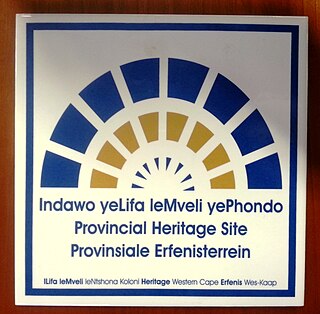
The aardwolf is a small, insectivorous mammal, native to East and Southern Africa. Its name means "earth-wolf" in Afrikaans and Dutch. It is also called "maanhaar-jackal" or civet hyena, based on its habit of secreting substances from its anal gland, a characteristic shared with the African civet. The aardwolf is in the same family as the hyena. Unlike many of its relatives in the order Carnivora, the aardwolf does not hunt large animals. It eats insects and their larvae, mainly termites; one aardwolf can lap up as many as 250,000 termites during a single night using its long, sticky tongue.

Hyenas or hyaenas are any feliform carnivoran mammals of the family Hyaenidae. With only four extant species, it is the fifth-smallest biological family in the Carnivora, and one of the smallest in the class Mammalia. Despite their low diversity, hyenas are unique and vital components of most African ecosystems.
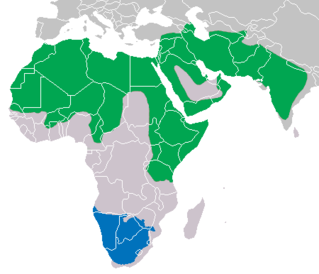
Hyaena is a genus comprising two of the living species of hyenas: the striped hyena from western Asia and northern Africa and the brown hyena from southern Africa. The brown hyena has sometimes been placed in a separate genus Parahyaena, or even included in the otherwise fossil genus Pachycrocuta, but recent sources have tended to place it in Hyaena.
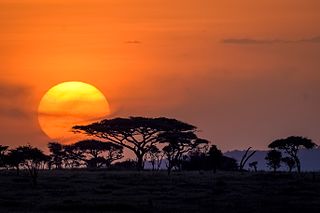
The Serengeti ecosystem is a geographical region in Africa. It is located in northern Tanzania. It spans approximately 30,000 km2 (12,000 sq mi).

The lion is a species in the family Felidae; it is a muscular, deep-chested cat with a short, rounded head, a reduced neck and round ears, and a hairy tuft at the end of its tail. The lion is sexually dimorphic; males are larger than females with a typical weight range of 150 to 250 kg for males and 120 to 182 kg for females. Male lions have a prominent mane, which is the most recognisable feature of the species. A lion pride consists of a few adult males, related females and cubs. Groups of female lions typically hunt together, preying mostly on large ungulates. The species is an apex and keystone predator, although they scavenge when opportunities occur. Some lions have been known to hunt humans, although the species typically does not.
The Tumbuka are an ethnic group living in Malawi, Zambia, and Tanzania. In Tumbuka mythology, Chiuta is the Supreme Creator and is symbolised in the sky by the rainbow.

The striped hyena is a species of hyena native to North and East Africa, the Middle East, the Caucasus, Central Asia and the Indian subcontinent. It is listed by the IUCN as near-threatened, as the global population is estimated to be under 10,000 mature individuals which continues to experience deliberate and incidental persecution along with a decrease in its prey base such that it may come close to meeting a continuing decline of 10% over the next three generations.

The brown hyena, also called strandwolf, is a species of hyena found in Namibia, Botswana, western and southern Zimbabwe, southern Mozambique and South Africa. It is currently the rarest species of hyena. The largest remaining brown hyena population is located in the southern Kalahari Desert and coastal areas in Southwest Africa.

The spotted hyena, also known as the laughing hyena, is a hyena species, currently classed as the sole member of the genus Crocuta, native to Sub-Saharan Africa. It is listed as being of least concern by the IUCN on account of its widespread range and large numbers estimated between 27,000 and 47,000 individuals. The species is, however, experiencing declines outside of protected areas due to habitat loss and poaching. The species may have originated in Asia, and once ranged throughout Europe for at least one million years until the end of the Late Pleistocene. The spotted hyena is the largest known member of the Hyaenidae, and is further physically distinguished from other species by its vaguely bear-like build, its rounded ears, its less prominent mane, its spotted pelt, its more dual purposed dentition, its fewer nipples and the presence of a pseudo-penis in the female. It is the only mammalian species to lack an external vaginal opening.

Barwon River, a perennial river that is part of the Murray–Darling basin, is located in the north-west slopes and Orana regions of New South Wales, Australia.

The Ngorongoro Conservation Area is a protected area and a World Heritage Site located 180 km (110 mi) west of Arusha in the Crater Highlands area of Tanzania. The area is named after Ngorongoro Crater, a large volcanic caldera within the area. The conservation area is administered by the Ngorongoro Conservation Area Authority, an arm of the Tanzanian government, and its boundaries follow the boundary of the Ngorongoro Division of the Arusha Region.

Were-hyena is a neologism coined in analogy to werewolf for therianthropy involving hyenas. It is common in the folklore of North Africa, the Horn of Africa and the Near East, as well as some adjacent territories. Unlike werewolves and other therianthropes, which are usually portrayed as being originally human, some werehyena lore tells of how they can also be hyenas disguised as humans.

The Lion King is a musical based on the 1994 Walt Disney Animation Studios' animated feature film of the same name with music by Elton John, lyrics by Tim Rice, and book by Roger Allers and Irene Mecchi, along with additional music and lyrics by Lebo M, Mark Mancina, Jay Rifkin, Julie Taymor, and Hans Zimmer. Directed by Taymor, the musical features actors in animal costumes as well as giant, hollow puppets. The show is produced by Disney Theatrical Productions.

The Fearless Hyena is a 1979 Hong Kong action comedy kung fu film written, directed by and starring Jackie Chan.

The cave hyena, also known as the Ice Age spotted hyena, was a paleosubspecies of spotted hyena which ranged from the Iberian Peninsula to eastern Siberia. It is one of the best known mammals of the Ice Age and is well represented in many European bone caves. The cave hyena was a highly specialised animal, with its progressive and regressive features being more developed than in its modern African relative. It preyed on large mammals, and was responsible for the accumulation of hundreds of large Pleistocene mammal bones in areas including horizontal caves, sinkholes, mud pits and muddy areas along rivers.

The red hartebeest is a species of even-toed ungulate in the family Bovidae found in Southern Africa. More than 130,000 individuals live in the wild. The red hartebeest is closely related to the tsessebe and the topi.

Mapungubwe National Park is a national park in Limpopo Province, South Africa. It is located by the Kolope River, south of the confluence of the Limpopo and Shashe rivers and about 15 kilometres (9.3 mi) to the NE of the Venetia Diamond Mine. The National Park borders mapesu private game reserve to the south. It abuts on the border with Botswana and Zimbabwe, and forms part of the Greater Mapungubwe Transfrontier Conservation Area. It was established in 1995 and covers an area of over 28,000 hectares. The park protects the historical site of Mapungubwe Hill, which was the capital of the Kingdom of Mapungubwe, as well as the wildlife and riverine forests along the Limpopo River. The Mapungubwe Hill was the site of a community dating back to the Iron Age. Evidences have shown that it was a prosperous community. Archaeologists also uncovered the famous golden rhino figurine from the site. It is one of the few places in Africa that has both meerkats and Nile crocodiles.
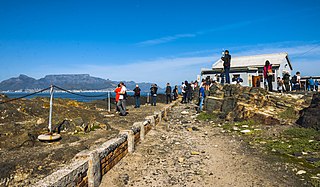
South Africa is a tourist destination and the industry accounts for a substantial amount of the country's revenue. According to the World Travel & Tourism Council, the tourism industry directly contributed ZAR 102 billion to South African GDP in 2012, and supports 10.3% of jobs in the country. The official national marketing agency of the South African government, with the goal of promoting tourism in South Africa both locally and globally is known as South African Tourism.
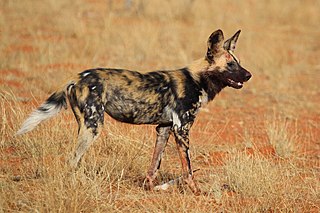
The African wild dog, also known as the painted hunting dog, painted wolf, African hunting dog,Cape hunting dog or African painted dog, is a canid native to sub-Saharan Africa. It is the largest of its family in Africa, and the only extant member of the genus Lycaon, which is distinguished from Canis by dentition highly specialised for a hypercarnivorous diet, and a lack of dewclaws. It was classified as endangered by the IUCN in 2016, as it had disappeared from much of its original range. The 2016 population was estimated at roughly 39 subpopulations containing 6,600 adults, only 1,400 of which were reproductive. The decline of these populations is ongoing, due to habitat fragmentation, human persecution and disease outbreaks.

Phiri is a township in the urban area of Soweto, in the city of Johannesburg in South Africa. The township was founded in 1956, as part of the demographic reorganization started by the state that year. Phiri, along with several other areas, was created to house Sotho and Tswana-speakers. Phiri is the Sotho word for hyena.
